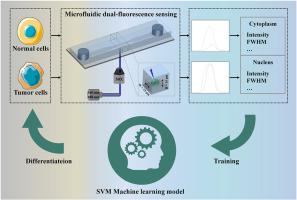当前位置:
X-MOL 学术
›
Anal. Chim. Acta
›
论文详情
Our official English website, www.x-mol.net, welcomes your feedback! (Note: you will need to create a separate account there.)
Machine learning assisted microfluidics dual fluorescence flow cytometry for detecting bladder tumor cells based on morphological characteristic parameters
Analytica Chimica Acta ( IF 5.7 ) Pub Date : 2024-06-22 , DOI: 10.1016/j.aca.2024.342899 Shuaihua Zhang , Ziyu Han , Hang Qi , Zhihong Zhang , Zhiwen Zheng , Xuexin Duan
Analytica Chimica Acta ( IF 5.7 ) Pub Date : 2024-06-22 , DOI: 10.1016/j.aca.2024.342899 Shuaihua Zhang , Ziyu Han , Hang Qi , Zhihong Zhang , Zhiwen Zheng , Xuexin Duan

|
Bladder cancer (BC) is the most common malignant tumor and has become a major public health problem, leading the causes of death worldwide. The detection of BC cells is of great significance for clinical diagnosis and disease treatment. Urinary cytology based liquid biopsy remains high specificity for early diagnosis of BC, however, it still requires microscopy examination which heavily relies on manual operations. It is imperative to investigate the potential of automated and indiscriminate cell differentiation technology to enhance the sensitivity and efficiency of urine cytology. Here, we developed a machine learning algorithm empowered dual-fluorescence flow cytometry platform (μ-FCM) for urinary cytology analysis. A phenotype characteristic parameter () which correlated with the size of the cell and nucleus was defined to achieve the differentiation of the BC cells and uroepithelial cells with high throughput and high accuracy. Based on analysis, SV-HUC-1 cells were almost differentiated from EJ cells and effectively reduced the overlap with 5637 cells. To further differentiate SV-HUC-1 cells and 5637 cells, support vector machine (SVM) machine learning algorithm was optimized to assist data analysis with the highest accuracies of 84.7 % for cell differentiation including the specificity of 91.0 % and the sensitivity of 75.0 %. Furthermore, the false positive rate (FPR) compensation enabled the detection rates of rare BC cells predicted by the well-trained SVM model were close to the true proportions with the recognition error in 0.4 % for the tumor cells. As a proof of concept, the developed μ-FCM system successfully demonstrates the capacity to identify the distribution of exfoliated cells in real urine samples. This system underscores the significance of integrating AI with microfluidics to perform high-throughput phenotyping of exfoliated cells, offering a pathway toward scalable, efficient, and automatic microfluidic systems in the fields of both biosensing and in vitro diagnosis of BC.
中文翻译:

机器学习辅助微流控双荧光流式细胞术基于形态特征参数检测膀胱肿瘤细胞
膀胱癌(BC)是最常见的恶性肿瘤,已成为一个重大的公共卫生问题,是全球死亡的主要原因。 BC细胞的检测对于临床诊断和疾病治疗具有重要意义。基于尿细胞学的液体活检对于 BC 的早期诊断仍然具有较高的特异性,然而,它仍然需要显微镜检查,这在很大程度上依赖于手动操作。迫切需要研究自动化和无差别细胞分化技术的潜力,以提高尿液细胞学的灵敏度和效率。在这里,我们开发了一种机器学习算法,支持双荧光流式细胞术平台(μ-FCM),用于尿细胞学分析。定义了与细胞和细胞核大小相关的表型特征参数(),以实现BC细胞和尿路上皮细胞的高通量和高精度分化。分析发现,SV-HUC-1细胞与EJ细胞基本分化,有效减少了与5637细胞的重叠。为了进一步区分 SV-HUC-1 细胞和 5637 细胞,优化了支持向量机 (SVM) 机器学习算法以辅助数据分析,细胞分化的准确度最高为 84.7%,包括 91.0% 的特异性和 75.0% 的灵敏度。此外,假阳性率 (FPR) 补偿使训练有素的 SVM 模型预测的罕见 BC 细胞的检出率接近真实比例,肿瘤细胞的识别误差为 0.4%。作为概念验证,开发的 μ-FCM 系统成功展示了识别真实尿液样本中脱落细胞分布的能力。 该系统强调了将人工智能与微流控相结合以对脱落细胞进行高通量表型分析的重要性,为BC生物传感和体外诊断领域的可扩展、高效和自动微流控系统提供了一条途径。
更新日期:2024-06-22
中文翻译:

机器学习辅助微流控双荧光流式细胞术基于形态特征参数检测膀胱肿瘤细胞
膀胱癌(BC)是最常见的恶性肿瘤,已成为一个重大的公共卫生问题,是全球死亡的主要原因。 BC细胞的检测对于临床诊断和疾病治疗具有重要意义。基于尿细胞学的液体活检对于 BC 的早期诊断仍然具有较高的特异性,然而,它仍然需要显微镜检查,这在很大程度上依赖于手动操作。迫切需要研究自动化和无差别细胞分化技术的潜力,以提高尿液细胞学的灵敏度和效率。在这里,我们开发了一种机器学习算法,支持双荧光流式细胞术平台(μ-FCM),用于尿细胞学分析。定义了与细胞和细胞核大小相关的表型特征参数(),以实现BC细胞和尿路上皮细胞的高通量和高精度分化。分析发现,SV-HUC-1细胞与EJ细胞基本分化,有效减少了与5637细胞的重叠。为了进一步区分 SV-HUC-1 细胞和 5637 细胞,优化了支持向量机 (SVM) 机器学习算法以辅助数据分析,细胞分化的准确度最高为 84.7%,包括 91.0% 的特异性和 75.0% 的灵敏度。此外,假阳性率 (FPR) 补偿使训练有素的 SVM 模型预测的罕见 BC 细胞的检出率接近真实比例,肿瘤细胞的识别误差为 0.4%。作为概念验证,开发的 μ-FCM 系统成功展示了识别真实尿液样本中脱落细胞分布的能力。 该系统强调了将人工智能与微流控相结合以对脱落细胞进行高通量表型分析的重要性,为BC生物传感和体外诊断领域的可扩展、高效和自动微流控系统提供了一条途径。






































 京公网安备 11010802027423号
京公网安备 11010802027423号